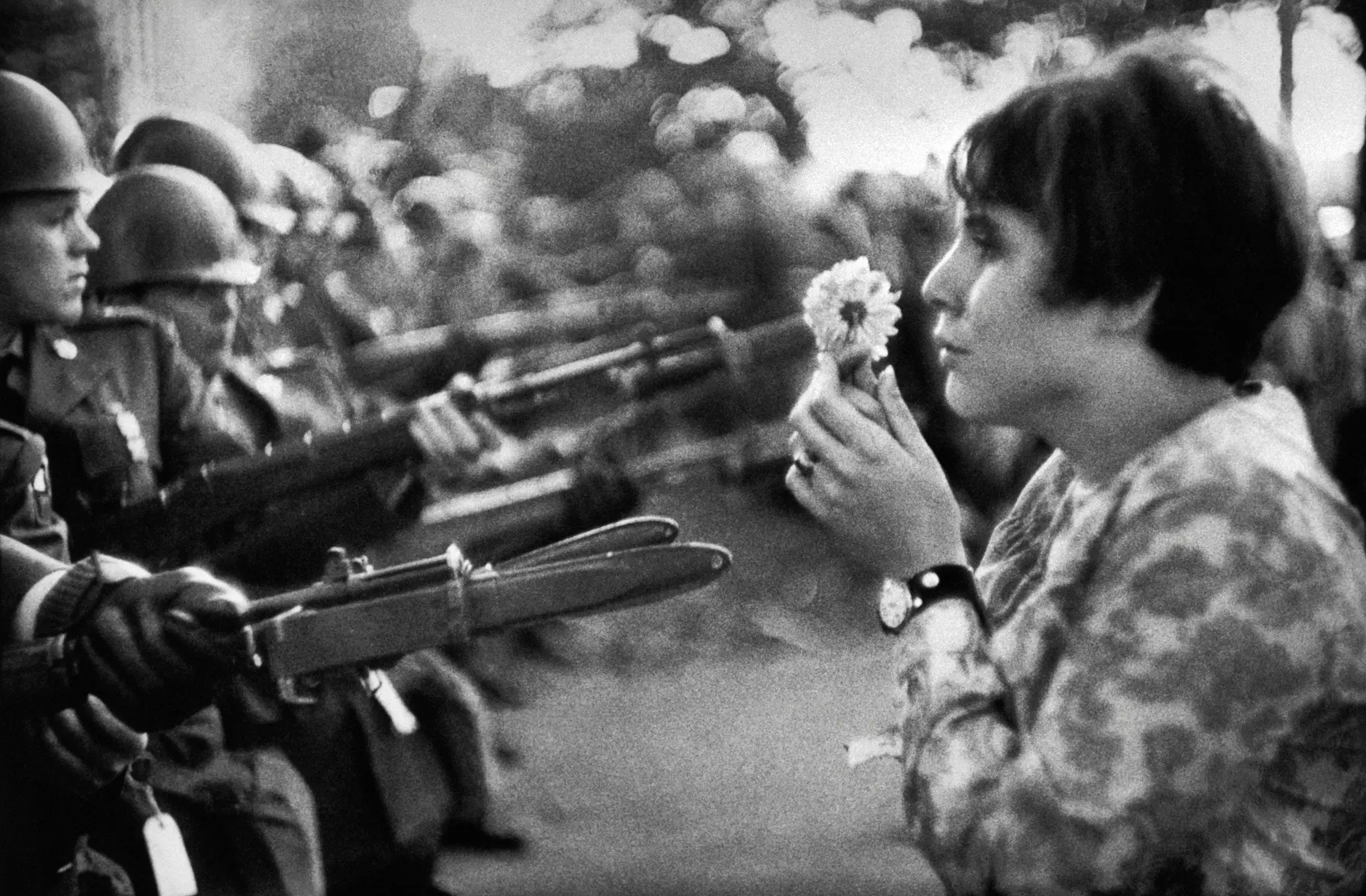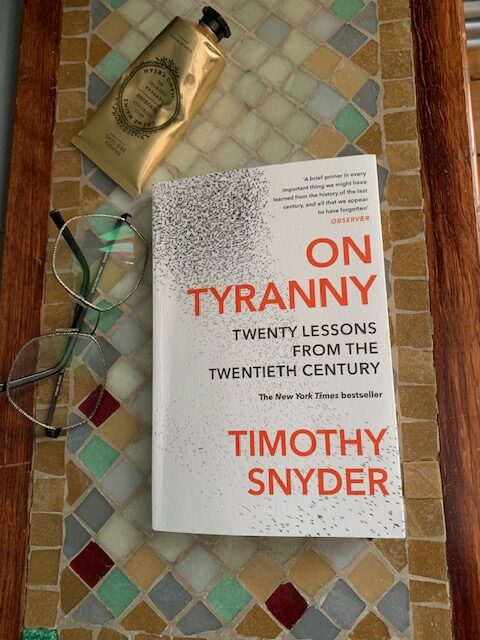Sudan, from hope to despair
On October 21, 1967, almost 100,000 people marched on Washington, D.C. to peacefully demonstrate around the buildings of the Pentagon in protest against the war in Vietnam. A war stigmatized by gross human rights violations and atrocities committed by the U.S. army as well as the loss of the irreplaceable lives of approximately fifty-seven thousand young Americans fallen on the battlefield. In the midst of that great momentum, Ms. Jan Rose Kasmir (17 years old) walked about forty feet out of the crowd as she held up a chrysanthemum flower towards a row of bayonet-wielding National Guard soldiers.
The photograph of that precise moment, taken by Marc Riboud, became an everlasting icon that crystalizes the strength and power of peaceful protest and symbolizes the profound contradiction between the fragility of peace and life and the ruthlessness of war and demise.
With regards to the remarkable leading role played by the Sudanese youth, most notably young women, its geographical range and pacifistic nature of the civilian revolt against the merciless oppressive nature of the regime in power, the December 2018 revolution in Sudan is undoubtedly the greatest peaceful revolution in all its modern history since its independence in 1956.
Unlike both preceding peaceful mass uprisings of October 1964 and April 1985, which essentially took place in Khartoum , the protests in 2018 were instigated in rural areas, beginning from Mayerno village on the blue Nile western river bank on December 6, then extended to other peripheral medium size urban centres like Nyala, Damazine, Atbara and others, before finally reaching its culminating point on the 25th of the same month at the heart of Khartoum’s commercial centre, less than a mile away from the historical presidential palace.
Almost 15 weeks and tens of demonstrations later and at the cost of hundreds of lives of young peaceful protestors, intentionally executed by the regime’s oppressive forces, the notorious Islamist dictator G. El Bashir’s reign was brought to an end on April 11, 2019. Paving the way for a long and tedious negotiation process between the Transitional Military Council, TMC, constituted by the Generals in control of the different military and security forces on one hand, and the then main civilian political coalition, FFC, on the other.
In the early morning hours of June 3, 2019, lots of circumstantial evidence, and a clearly identified military chain of command, strongly suggests the direct involvement of many TMC Generals in orchestrating a meticulously planned and despicable massacre against thousands of protestors participating in the two months long sit-in at the gates of the army’s headquarters. Hundreds of whom were killed, some thrown handcuffed, alive, with cement blocks tied to their feet, into the river Nile. Despite its horrific nature, the sit-in massacre did not end the talks, eventually resumed days later pursuant to the mammoth demonstrations of June 30, 2019, that took hundreds of thousands of protestors to the streets of Khartoum.
A few weeks later a political deal was struck to form a civilian led Transitional Government, TG. The TG was officially inaugurated two months later on August 2019, led by Prime Minister Dr. Abdallah Hamdok, a former deputy executive secretary of the United Nations’ Economic Commission for Africa (UNECA). Simultaneously an 11-member Transitional Sovereign Council, TSC, was formed combining both civilian and military representatives. The presidency of the TSC was attributed to the Sudanese Armed Forces’, SAF, commander in chief G. Burhan and the vice presidency to his long-time ally, the Rapid Support Forces’, RSF, commander G. Daglo (Hemedti).
During the four months long peaceful demonstrations that took place before the dethroning of El Bashir the main and most famous slogan chanted by thousands of protestors was ;“Freedom, peace and justice, the revolution is the choice of the people” but others still remain in the collective memory as well, most distinctively ;“We are out here for your own sake …imbecile!” shouted by young defenceless men and women confronted by the regime’s soldiers who were, more than ever, shielded by layers of institutional immunity tricks and stratagems ensuring utter impunity, ready to shoot them down with live ammunition at any moment. Addressing the soldiers then, unlike Ms. Jan Rose Kasmir did forty years ago, from an approximate “illusional” safety buffer distance of forty feet. Forty golden feet that marks the difference between peacefully protesting as a fundamental right in the context of the misfunctioning judiciary system and the profoundly corrupt and distorted security sector of Sudan compared to demonstrating in a democratic country where the state apparatus abides by the rule of law and is committed to respect human rights, at least within its own borders, and where the law enforcement forces are under the strict control of the democratically elected governments and submitted to the rigorous judicial scrutiny and thorough civilians’ oversight.
On October 25, 2021, a Coup d’état was carried out by both leading Generals, Burhan and Hemedti, against the civilian led transitional government. By that time, 26 months had passed since the adoption of the constitutional transitional document. Months marked by recurrent deliberate interferences of the military component of the TSC in the executive mandate, beyond the TSC restricted jurisdictions, and a series of conspiracies against the civilian led government conducted by the military and backed up by the huge networks of Islamists “The deep state”, members of the former El Bashir regime who were still strongly infiltrated in all key positions of the military and security apparatus.
As soon as the new authoritarian regime was announced and the news about the detention of some prominent civilian figures of the transitional government spread, people instantly took again to the streets. Under the pressure of the swift rejection by protestors, the isolation inflicted by the international and regional community on the -TO BE- new dictatorship, tensions began to rise gradually between the two accomplices. Both aspiring for absolute power, eventually dragging Sudan into a grave constitutional and institutional void that, despite of the civilians’ efforts to forge a political way out of it, fatally led to the implosion triggered on April 15, 2023 at the heart of the capital Khartoum.
Today, and after almost 432 days of nonstop fierce battles between Burhan’s SAF and Hemedti’s RSF, mostly taking place in densely inhabited urban centres, an estimated 150,000 civilian have been killed, hundreds of witnessed war crimes and crimes against humanity committed, more than 10 million people displaced from their homes, 1.8 of whom to neighbouring countries, thousands raped, lost or wounded and the lives of an additional 2 million Sudanese citizens, mostly women and children, are threatened by famine.
Sudan is now and by far the worst humanitarian crisis in the world, an unprecedented predicament in the 21st century. Nevertheless, and blurred by other higher profile crisis, Ukraine, Gaza, the rise of popularism and the extreme right in the west, it remains an almost forgotten catastrophe in the international public opinion sphere.
Forgotten by some, ignored by others, this hideous and senseless conflict is catalysed by some very intrusive regional and international ambitious regimes and financed by siphoning Sudan’s natural resources, most notably the abundant gold mineral among others.
The war in Sudan, if not taken seriously with urgency, and its two belligerents held accountable for their crimes, will inevitably jeopardise the stability of the whole Eastern African region, already extremely fragile, and will furthermore provide the suitable environment for the prevalence of Islamic extremist groups, organised crime cartels and mass clandestine migration of millions in the very foreseeable future.
Fortunately, a glimpse of hope is still there, manifested in the Sudanese civil society that led the December 2018 revolution in the first place. Despite formidable obstacles and against all odds the Sudanese civil society has been remarkably resilient and has reasserted, time and again, its extreme vivacity by forming the largest pro-democracy civilian front in the history of Sudan “Tagadom” on May 30, 2024. A coalition that rallies a large number of political forces, professional organisations, resistance committees and other civil society organizations, with the sole goal of striving to attain a secession of hostilities between the armies of the two Generals, stop the war and launch a political process that may eventually lead to a peace agreement, and maybe, and hopefully to a national reconciliation and a full recovery and reconstruction of this beautiful country, Sudan.
Mahdi Berair, Sudanese Politician and Former Chief of Staff at the Ministry of Cabinet Affairs, Transitional Government of Sudan



